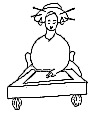
STUDY
Can you save a poem?
Rescue these poems by cutting them, writing an alternative line, and/or re-arranging them.
Waves
Waves hollow the base
of the great high cliffs –
water can wear down rock
Snail
The ultimate centre-point
of the snail’s spiral –
mystery of the soul

CRITICAL REFLECTION
Waves. The issue here is: trusting the image to speak to the reader, and trusting the reader to get the point. The image of waves hollowing the base of a cliff shows you all you need to know about erosion. To tell the readers, in the last line, what the conclusion is that any attentive reader will already have reached is insulting and unnecessary. How did you rescue the poem? Give yourself a prize if you cut the last line.
Then, what did you put in its place?
You could have put almost anything, except the "summing up" in the third line as given. Add to the picture of the scene with wheeling seagulls, flying spray, a fishing boat or summer clouds. Or pick up another image of time or erosion: fossils in the rock, or smooth round pebbles, or "my wrinkled hands." Give yourself another prize if you had a good solution to the problem of the last line.
Snail: The same issue arises with this example. Drawing attention to the point at the centre of the shell's spiral is an interesting and suggestive observation, but it is only suggestive and interesting if you don’t tell the reader what it suggests. To do so, closes down the reader’s imaginative space to nothing. The windy, phoney profundity of the last line ruins the observation. Give yourself a pat on the back if you cut the last line.
Then, what did you put in its place?
You could have put almost anything concrete. You could have simply added to the picture of the scene with a line giving us the weather, or some detail to suggest the place or time or season. Or, more ambitiously, you could have picked up on the implied themes of shape, centre or spiral with a line about a wheel, bowl, pared apple-peel or staircase (but not a DNA double-helix spiral, which is too much of an idea, not an observation we can make). Or perhaps you would decide to use a contrasting shape: something square, perhaps, or something hollow, without a centre, like a Henry Moore sculpture or an old tyre. Give yourself a pat on the back if you found a good image to go with the snail’s spiral – and something as simple as "Spring rain" would be perfectly good enough.
The rule you have learned here is:
"Don’t sum up for the image!"

WRITE
Control your language
Can you give your reasons for preferring one or the other of these versions of haiku?
A
The bees are agitated,
and pointy ripples
rush on the water
B
The bees pirouette
and multi-faceted shimmering ripples
dance on the sparkling lake
A
The proud golden rays of the sun
fiercely batter the parasol –
but in vain!
B
Intergalactic zap-rays
stopped
by the parasol

CRITICAL REFLECTION
The A and B versions of "The bees" are clearly written by people with quite different ideas about what is "poetic." B uses a much grander, more attention-seeking, more glamourising (and more Latinate) choice of English words. A is plainer, more conversational (and more Anglo-Saxon). But what is the effect achieved?
A seems to be about a change in the weather, and its mood is threatening. A storm is coming, the wind is getting up and the temperature will drop dramatically, one guesses. Whatever one thinks of the elegance of the diction, the little poem has a real subject and records two precise observations.
B seems to be about its own language preening itself. One could not guess from this what the change in the weather might be, though it seems to be sunny and the bees are enjoying themselves. This is, of course, a caricature of what was once thought to be a "poetic" style and is now usually seen as a camp, sequined, over-rouged cliché.
A and B of the "Sun’s rays" poems also show contrasting word-choices. In A the language is trying too hard, perhaps, to be dramatic and becomes melodramatic. It personifies the sun with a character like one of the Greek gods, which is more pompous and overblown than we usually like in this democratic age. B might not appeal to you much either, if you like your language elegant – the first line seems to come out of a science-fiction comic – but it has at least the virtue that it gives the reader a little shock of surprise that such powerful rays could be stopped by a parasol. The A version does not succeed in doing this because it over-eggs the emotion and consequently muddles the effect of the observation.
Note to Teachers:
Make it explicit to your students that you are not seeking some fancy ideal of "poetic diction." They should not show off with multisyllabic words, and glamourise or sentimentalise the subject out of a mistaken belief that that is what poetry requires.


